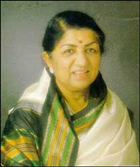Born on 28th September 1929 in Indore (M.P.), Lata Mangeshkar is one of the greatest singers India has ever produced. Mangeshkar family could very well be called the premier musical family of India as father Pt. Dinanth and 5 siblings- Lata, Usha, Asha (Bhosle), Meena (Khadikar) and Hridaynath have all contributed immeasurably in the field of popular music as singers and composers.
Lata recorded her first song Naachu yaa gade khelu saari for a Marathi film ‘Kiti hasaal’(1942) and in ‘Aap ki seva mein’ (1947), she made her playback singing debut for Hindi films with the song Paa laagun kar jori. Even though she has sung in excess of 7500 songs in many different languages, her maximum output and best works are in Hindi, Marathi and Bengali.
As a singer, her main body of work comprises of film songs. Simplicity and easy accessibility of this musical form coupled with Lata’s matchless virtuosity and versatility has made her a national cultural icon that has stood the test of time. It is the class, creativity, critical acclaim and cultural impact, not to mention the consistent commercial success of her musical output that has set her apart from her contemporaries and has given her the status of proverbial ‘Melody queen of India’. Most of the stalwarts in Indian Classical music have praised her role in popularizing their genre in masses through her semi-classical film songs. The legendary classical singer Ustad Bade Ghulam Ali Khan had once affectionately called Lata as ‘Ustadon ki ustaad’. Commercially speaking, various film soundtracks and non-film albums dominated by her songs have been topping the charts for more than five decades and have sold in millions.
Her songs occupy pride of place in the music of almost all top maestros of Hindi film music and have been associated with many an important milestone in Indian cinema - ‘Barsaat’, ‘Mother India’, ‘Madhumati’ and ‘Mughal-e-aazam’ being prime examples in the ‘Golden era’ of fifties and sixties and the list continuing with ‘Paakeeza’, ‘Bobby’, ‘Ram teri Ganga maili’, ‘Maine pyar kiya’, ‘Hum appke hain kaun’ and ‘Dil to paagal hai’ in the modern era after the seventies.
Her emotional rendition of the patriotic song- ‘Ai mere watan ke logon’ after the Chinese aggression had moved the late Prime Minister Jawaharlal Nehru to tears. Many of her non-film albums like ‘Meera Bhajan’, ‘Chaala vaahi des’, ‘Lata sings Ghalib’, ‘Dnyaneshwar mauli’, ‘Koli geete’, ‘Ganpati aarati’, ‘Abhang Tukayache’, ‘Shivkalyanraja’, ‘Ram Shyam Gungaan’, ‘Sajda’ and ‘Shraddhanjali’ have carved a musical niche of their own.
She composed songs for a few Marathi movies in fifties and sixties, mostly under the pseudonym ‘Anandghan’. As a composer, her flair for melody and ability to smoothly blend classical and folk music won her the ‘Maharashtra State best composer award’ for the film ‘Saadhi maanse’ (1965).
All probable major musical awards at the regional and national level have come her way sometime or the other. In 2001, Indian government conferred upon her the highest civilian honour - the ‘Bharat Ratna’. Three state governments- Madhya Pradesh, Maharashtra and Goa- have each separately instituted an annual ‘Lata Mangeshkar award’ for honoring senior artists in popular music for lifetime achievement.
While choosing her as one of the four ‘Indians of Twentieth century’ along with Mahatma Gandhi, Swami Vivekanand and Dhirubhai Ambani, the ‘Times of India’ said, """"All of them are self-made individuals; they did not have the advantage of wealth, aristocracy or cast; they fought adversity and believed in action- karmayogis in true sense.


